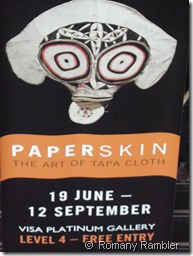When we visited Te Papa Museum several weeks ago, we were very interested to see a demonstration on making tapa cloth. This return visit was to view the exhibition “Paperskin”. Unfortunately, we were not allowed to take photos inside the exhibition, and were only permitted to take this one of the entrance. All other photos are courtesy of Te Papa’s website.
Taking pride of place was the magnificent 23 metre long ngatu launima which has royal connections. The imagery includes royal crowns, geometric patterns, and floral motifs. Made in 1953 to commemorate Queen Elizabeth II’s visit to Tonga, we noticed that the name Elizabeth is painted inside each of the crowns. It was later placed under Queen Salote’s coffin when her body was flown back from New Zealand in 1965. The tapa was given to Flight Lieutenant McAllister, who piloted the plane which took Queen Salote’s body back to Tonga, and he in turn presented it to the Museum in 1968. This huge piece of tapa cloth dominated the exhibition room with it’s sheer size, and this photo does not do it justice.
Examples of tapa cloth from Hawaii, Tahiti, Fiji, Cook Islands, Samoa, Vanuatu and Papua New Guinea were hung, and the designs were clearly different amongst the island communities. Bark from the paper mulberry tree, the banyan and breadfruit trees is all used by the different islanders to make tapa cloth.
 Tapa cloth from American Samoa
Tapa cloth from American Samoa
There was a large selection of ceremonial masks on display, some being very tall at 4 metres high, which are worn by women. The smaller men’s masks are usually destroyed after the ceremony. Made with a wicker frame, they are covered with tapa cloth. An unusual double headed crocodile was made to be carried during dancing rituals.
Some of the tapa cloth was extremely old. There was a fragment of Hawaiian cloth that was reputed to have been collected during Captain James Cook’s voyage in the 1770s. We are well aware that this craft is extremely time consuming and it was interesting seeing so many examples produced by the different South Sea Islands over such a long time frame. If you are visiting Wellington we can certainly recommend a visit to “Paperskin”.


No comments:
Post a Comment